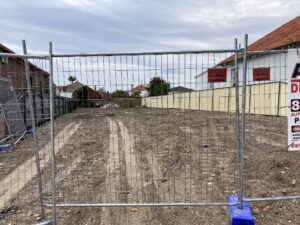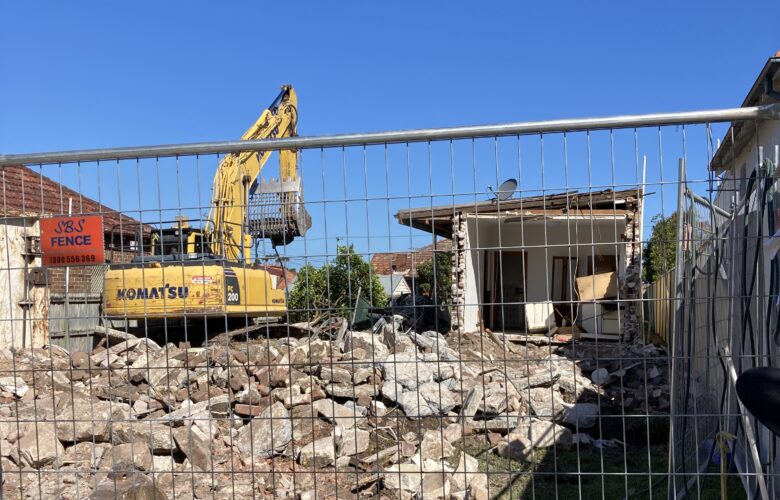Part Three – Frank’s Body
Read Part One and Part Two here.
It is surprisingly easy to demolish a house. The paperwork is fairly straightforward; the process has to be certified by council, neighbours need to be notified, and the electricity has to be disconnected from the property. All up, it took about six hours of admin to organise from my end (although not all at once). A certifier dealt with council and the approval took only a few days after the paperwork was submitted. We had to give seven days notice to all the neighbours whose properties touched our boundary (four houses), plus a couple of the houses across the road. Then the demolition company put up a fence and started work.
On the first day, they removed all the external asbestos (mostly in the eaves and roof cavity), as well as all the roof tiles.
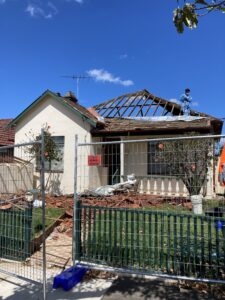
The second day, they brought in a 20 tonne excavator. First they demolished the small single car garage and parked a huge skip bin there. Then they plucked off the roof timbers, saving them for recycling. Once the roof was gone, it didn’t take long to knock over the brick walls.

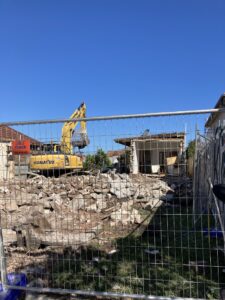
By the third day, they had the entire structure demolished and were commencing the final stage – cleaning up the bricks for recycling and taking everything away to leave a blank piece of land for the builders. Around lunch time, I had a phone call from site.
“Can you come out to site? We’ve found something and we need to talk about it.”
“Sure.”
I rang Mr Dahlia in case he wanted to come along too.
“What did they find?” he asked.
“I’m not sure. I couldn’t really work it out from what he said.”
“What if it’s Frank’s body?” That’s a hell of an imaginative leap – Frank was the husband of the woman we bought the house off. He’d died years ago; something we knew because they’d left all their paperwork behind.
It wasn’t Frank’s body, but it was Frank’s handy work. When he’d built the extension, he’d demolished an asbestos lean-to, and used all the pieces of asbestos as fill for the extension. The only plus-side was that he’d kept the contaminated fill contained by putting it inside the brick footings for the extension. He’d then concreted over the top of it, keeping it safely contained for decades until we found it. Surprise!
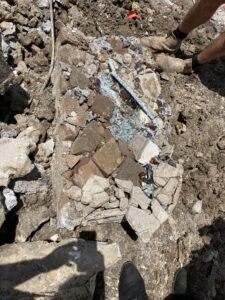 Image: The underside of the concrete floor of the 1970s extension, showing the mixture of dirty fill used.
Image: The underside of the concrete floor of the 1970s extension, showing the mixture of dirty fill used.
Of course, removing it wasn’t included in our original quote because nobody knew it was there. And being a notifiable environmental poison, it had to be done with a special process (aka a lot more cost). Thankfully we have a contingency fund for this build, although I didn’t particularly want to spend a bunch of it so early in the build process. We negotiated a per ton rate; although it’s a stretch to call it a negotiation when the demolition company knew we wouldn’t be allowed to do anything else on site until all the asbestos was safely removed. At least there would be no quibble over the quantity as it all had to be certified.
Is it wrong to call the contaminated fill ‘Frank’s body’?
It wasn’t all bad news. The old part of the house had sandstone footings which nobody expected to find. From the outside, the house looked like it had painted brick footings. The excavator driver saved all the sandstone for us, as well as 128 bricks from the oldest part of the house. Why 128? Because we are going to make an outdoor chess board (64 squares made from 2 bricks each). To be technical, the excavator driver didn’t save us exactly 128 bricks, just a pile of them, so we might have a few spares too to use as garden edging or maybe even a path? Time will tell…
